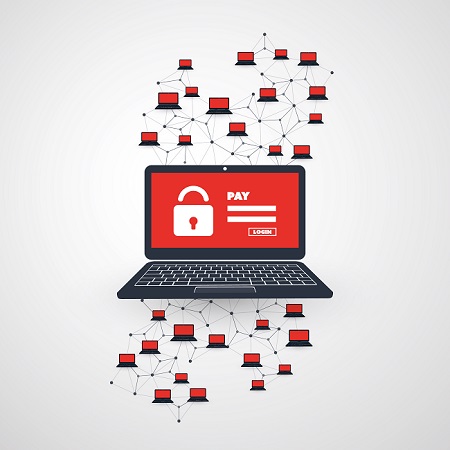As the digital landscape evolves, so do the threats that businesses face in the form of cybercrime. The days of relying solely on preventive measures to safeguard your network and data are long gone. With the surge in ransomware attacks, business email compromise, and password exfiltration, cybercriminals have become more adept at breaching even the most robust defenses. As a result, the way we approach technology and cybersecurity must also evolve. Ransomware Preparedness will be key!
Plan For The Attack
It’s comfortable for technology teams to discuss network security in terms of loss prevention. Antivirus software prevents network infections. Firewalls prevent unauthorized access. User access policies prevent data leakage, and backups prevent data loss.
That might have made sense five to ten years ago, when most businesses did successfully prevent each outsider attack. In those days, ransomware attacks were uncommon, and most cybercriminals simply encrypted files and hoped the target didn’t have data backups.

Today, businesses are subject to constant ransomware, business email compromise and password exfiltration attacks. The attackers use phishing emails, stolen employee credentials, and sophisticated attacks that compromise hundreds or thousands of business networks simultaneously.
If your business is big enough to celebrate an employee’s birthday most months of the year, it’s big enough to face hundreds of these attacks each month of the year. And eventually, despite heroic efforts to prevent them, one of these attacks will make it through your perimeter defenses.
Any organization that wants to prepare for a security breach needs a well-defined incident response plan. Outline the steps to take in the event of a breach through an incident response plan. This can help to minimize the damage and disruption caused by the incident.
Key elements for your incident response plan:
Roles and responsibilities
The plan should clearly define the roles and responsibilities of the various individuals and teams involved in the incident response process. This includes identifying who will be responsible for notification, containment, eradication, recovery, and post-incident analysis.
Communication plan
The plan should include a communication plan that outlines how the organization will communicate with employees, customers, and other stakeholders during and after a breach. The plan should ensure that everyone who needs to know about the breach is informed in a timely and accurate manner.
Incident response procedures
The plan should include detailed procedures for responding to different types of incidents. These procedures should be specific and actionable, and they should be based on the organization’s specific security requirements.
Testing and maintenance
You should regularly test and maintain the plan to ensure that it is up-to-date and effective. This includes testing the plan’s procedures and communication channels, as well as reviewing the plan’s overall effectiveness.
By having a well-defined incident response plan in place, organizations can minimize the damage caused by a breach and help to protect their reputation and bottom line.
Reliability Matters
When it comes to technology partners, reliability is paramount. We’ve all experienced the frustration of trying to reach giant companies like Facebook, where phone support seems non-existent despite their immense size and resources. That’s why opting for a local business with dedicated customer service becomes a wise choice.
In times of crisis, such as a potential network breach, having IT support that promptly picks up the phone is essential. But it goes beyond that; you need a team that can swiftly identify and neutralize threat actors on your network, lock down the system, and proactively monitor for any other vulnerabilities. Additionally, the ability to investigate the attack source becomes critical, especially when dealing with insurance claims that involve complex technical inquiries.
In such situations, you can’t rely solely on your internal staff or small IT managed services providers. You need an IT service provider that aligns with the famous business slogan “Big enough to serve you, and small enough to care.”
A dependable managed IT service provider (MSP) should be able to quickly provide knowledgeable engineers whenever you need them most, be it for major projects, office relocations, company growth, or even unfortunate cyberattacks. Many MSPs boast expertise in these areas and claim to have well-established processes for handling worst-case scenarios.
But words aren’t enough. When evaluating potential partners, it’s crucial to ask for concrete examples of how they’ve effectively addressed problems similar to those your business might encounter. Seek insights into their office relocation checklists and project management processes to gauge their preparedness.
Above all, their incident response systems and past performance matter most. An operationally mature MSP won’t be “winging it”; they’ll have robust processes in place and will be eager to discuss their track record with you.
Proactive Backup Protection
Threat actors do typically look around on a network before encrypting files. And if they only have time to find one thing, they’re going to find your backups. Without a backup, businesses are far more likely to pay a ransom.
They know that company leaders are much less likely to pay a ransom if they can quickly restore all their critical data from a backup. And while hackers might threaten to leak embarrassing emails, company financial data or customer credit card numbers, they might simply come up empty handed on those things. If an attacker can find a way to corrupt, delete, or encrypt your backups, they’re going to do it.
That’s why the details of a backup solution are so critical. You must determine the storage location of backups, the credentials needed to disable backups or alerts, and whether the backup files allow modifications or remain immutable after creation. The protection of backup files against ransomware attacks has become a game of whack-a-mole, with backup solution vendors constructing safeguards to defend the files and hackers devising new methods to evade these protections.
Despite the considerations mentioned, backups remain highly effective and valuable. They serve as the last line of defense against a successful ransomware attack on your network. However, it is crucial to equip your IT team or Managed Service Provider (MSP) with more comprehensive information than what is provided in a vendor’s marketing materials before relying on data backups on autopilot.
Be Ready to Respond
The frequency and sophistication of cyberattacks are increasing, making it more important than ever for businesses to be prepared. A comprehensive ransomware preparedness plan should include the following elements:
A strong incident response plan
This plan should outline the steps that will be taken to minimize the damage caused by a breach, including who will be notified, how communications will be managed, and how data will be restored.
A reliable technology partner
This partner should have the expertise and resources necessary to respond to a successful cyberattack, including the ability to identify and neutralize threat actors, lock down the system, and proactively monitor for vulnerabilities.
A robust backup solution
This solution should be designed to protect data from ransomware attacks, including features such as immutable backups and encryption.
By taking these steps, businesses can significantly reduce the risk of a ransomware attack and minimize the damage caused if one does occur.
And always remember to educate your employees to ensure they are not a cybersecurity liability.
To learn how WingSwept can help protect your company from emerging cyberthreats, contact us!

